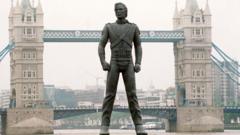As Michael Jackson's 30-foot-tall statues, created to promote his album HIStory, fade from public view, various accounts recount their current status, revealing a mix of preservation and neglect, scattered across the globe.
The Vanishing Statues of Michael Jackson: 30 Years Later

The Vanishing Statues of Michael Jackson: 30 Years Later
Exploring the fate of the giant fibreglass statues that celebrated Michael Jackson's legacy posthumously.
In June 1995, London witnessed a surreal spectacle when a colossal 32-foot statue of Michael Jackson was floated down the River Thames, capturing public attention as part of a marketing campaign for his landmark double album, HIStory: Past, Present and Future, Book I. This statue was one of ten created to symbolize the pop icon’s influence and was subsequently transported across the globe following Jackson on his concert tour. Now, three decades later, as discussions about Jackson's legacy grow increasingly complex and controversial, the whereabouts of these statues tell a story of both preservation and decay.
The journey of these statues began at Elstree Studios, where they were meticulously built and painted by a skilled team led by artist Stephen Pyle, commissioned by Sony Music. The statues, made of fibreglass, were designed after consulting sculptor Diana Walczak. While the first grand display occurred in London, the statues’ remaining fates vary widely.
One statue that once graced a McDonald's in Best, Netherlands became a local landmark, attracting Jackson fans who commemorated his life each year. However, pressures following the 2019 documentary “Leaving Neverland,” which reignited discussions concerning Jackson’s controversial life, led to its removal. The restaurant's owner, Peter Van Gelder, aimed to preserve the statue for fans but continues to face hurdles concerning permits, leaving it languishing under a tarp.
In Austria, a statue found its home in a now-defunct nightclub, where its owner, Franz Josef Zika, sought to leverage the statue's fame to attract visitors. As the venue faced closure due to nearby construction, Zika attempted to sell the statue but has encountered difficulties finding a buyer, reflecting a broader trend of declining public interest in Jackson memorabilia.
Meanwhile, sporadic sightings of other statues have been reported, including one in a Swiss fairground and another at an abandoned South African theme park, each carrying a different story of neglect or storage. In Italy, a statue has briefly appeared after restoration but is now listed for sale, suggesting the ongoing challenges of maintaining the legacy of a star whose public image remains contentious.
The remaining statues encapsulate a symbiotic relationship between art and celebrity: while they symbolize a time when Jackson was widely celebrated, their increasingly hidden locations mirror society's ambivalence toward his legacy. Ultimately, the stories behind these towering effigies of the King of Pop reflect a landscape of nostalgia, controversy, and the complexities of memorializing an iconic figure.





















